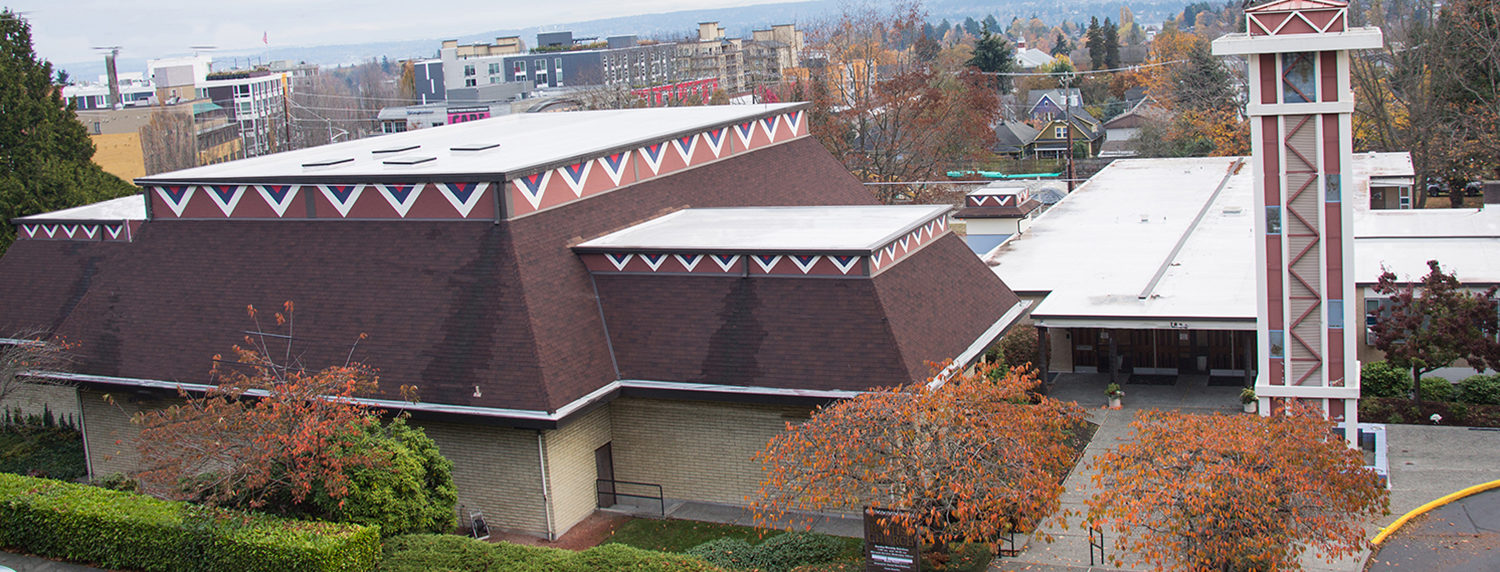Sanctuary
Much more than a wooden structure.
It is a gathering place for those seeking truth and salvation.
Much more than a wooden structure.
It is a gathering place for those seeking truth and salvation.
The sanctuary, dedicated on October 26, 1975, was built through the sacrifice and generous giving of the members of Mount Zion, many of whom are no longer with us.
Our sanctuary uses universal themes of simplicity and permanence to proclaim the enduring presence of God. The selection of unfinished wood posts from the natural Northwest environment is an affirmation of the tasks yet to be completed on our Christian journey to eternal life.

The resemblance to an African hut is no coincidence. It was architecturally designed to facilitate a close communal bond to Africa. The triangles on the borders of the three roofs symbolize the Trinity – God the father, God the Son, and God the Holy Spirit. The twelve supporting wooden beams represent the twelve tribes of Israel and the potential within each of us to become followers of Christ.
The floor plan of the Sanctuary is in the shape of the cross: the baptistery at the head, the pulpit and the communion table in the center, the choir stand and pipe organ extending north, the chapel extending south and the center aisle extending form the communion table to the east wall.
The flags bordering the front represent: Mount Zion Baptist Church, United States of America, Christianity World Council of Churches, United Nations Black Liberation National Council of Churches, National Baptist Convention USA, Inc., American Baptist Convention USA, State of Washington, African Americans.

The colors in the Sanctuary are red, representing divinity and the blood of Christ, and purple, representing royalty that belong to Christians because they are children of the King.
The skylights represent the four Gospel writers of the New Testament: Matthew, Mark, Luke, and John. They also reveal the light of Jesus Christ available to every believer.

Surrounding the church are eighteen stained glass windows manufactured by Mr. Douglas Phillips of Cleveland, Ohio. “The Church and the World” depicts persons who had made significant contributions in the history of African Americans. It is an artistic collection honoring outstanding leaders from the past whose vision and deeds made it possible for us to move into the future.
Nine pairs of windows provide a prism of colorful light in the Sanctuary and chapel. The green tinged with blue symbolizes hope, growth, and eternal life with the renewing from baptism. The blue suggests faithfulness and truth in the teachings of the Bible and the Church through our renewal from baptism. Violet, representing penance, is a visual reminder of Christ’s passion and suffering. The red reminds us of God’s love for humanity and the sacrifice He made for us. The last section of windows is a rainbow of all colors representing unity in God’s people

The appliquéd tapestry, which is the focal point of the pulpit (and hangs over the baptistery), was designed by Larry Metcalf, Professor of Art at Seattle Pacific University. The tapestry commissioned by the Mount Zion Building Committee for inclusion in the Afri-centric sanctuary, which was complete in 1975.
The EYE OF GOD represents God’s omniscience in the lives of the world’s inhabitants; it is a symbolic manifestation of God’s “all-seeingness.” The RAINBOW is a symbol of approval, representing God’s pardon and reconciliation with the human race after the great flood in the Bible. The HYSSOP, held securely in the beak of the dove, symbolizes penitence and humility. Its medicinal qualities as a purgative represents innocence regained (baptism).
The WATER symbolizes the acts of cleansing and purification. It is depicted as the ordinance of baptism, the immersion and washing of the sinful self and resurrection in the newness of a life in Christ.
The FISH reminds believers of the immersion of Jesus when he was baptized in the River Jordan. Early Christians used it as a sign to indicate that they were true followers of Christ.
To learn about the rich history of Mount Zion Baptist Church, go to our History page.